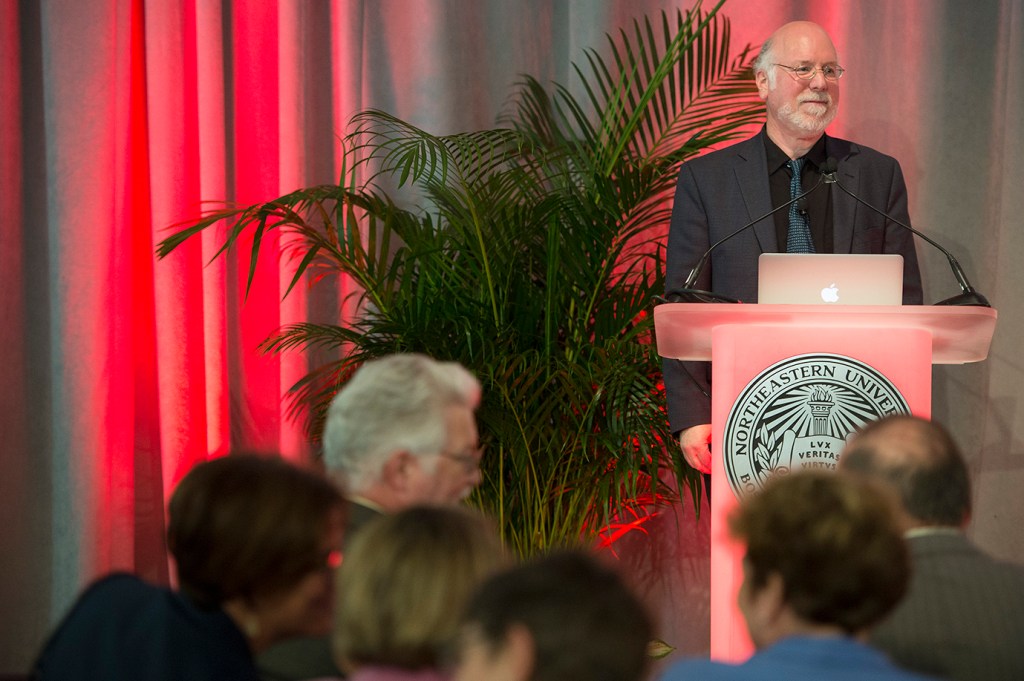The science of learning

What will the future of higher education look like?
That was the question addressed on Tuesday, when Northeastern University President Joseph E. Aoun brought esteemed psychologist Stephen M. Kosslyn, founding dean of the Minerva Schools at the Keck Graduate Institute, to campus to introduce the university community to a new model of undergraduate education.
Learning as a science
The one-hour interactive talk, followed by a Q&A led by President Aoun, explored “The Science of Learning”—a discipline based on empirical findings regarding human memory, perception, comprehension, and reasoning. To a capacity audience in the Egan Research Center’s Raytheon Amphitheater, Kosslyn explained how the science of learning shapes the seminar-style curriculum of San Francisco-based Minerva, a venture-capital funded for-profit institution launched in 2013.
“Lectures are a terrible way to learn,” said Kosslyn, noting that Minerva offers no auditorium-filled introductory classes. Instead, the four-year college focuses on helping students develop “core competencies” through “active learning”—discussions, intensive debates, and collaborative projects, with rigorous rubrics tracking students’ progress.
Instruction at Minerva is provided by professors in small online seminars: Students and teachers alike interact in real time and face-to-face via individual computers, where an onscreen grid with everyone’s image replaces the traditional classroom.
“We are going back to the roots of Western universities, where the students were the focus,” said Kosslyn, who served as director of the Center for Advanced Study in the Behavioral Sciences at Stanford University and chair of the psychology department and dean of social sciences at Harvard University before joining Minerva. “We hope that if what we do works well, other institutions will take what they find comfortable for them and import it.”
The power of active learning
As evidence of the power of active learning, Kosslyn pointed to a 2014 meta-analysis led by the University of Washington’s Scott Freeman showing that active learning raised exam scores in STEM—science, technology, engineering, and math—courses by 6 percent and that failure rates for students in traditional lecture courses were 1.5 times higher than for those in active learning classes.
He also had audience members experience that power themselves. Pairing off attendees, Kosslyn displayed a list of words via PowerPoint. One person in the pair had to judge whether a word named a living thing, the other to assess which words started with a tall letter, such as “h,” and ended with a short one, such as “e.” After he removed the words, Kosslyn asked everyone to write down the words he or she remembered.
Those assessing letter height remembered far fewer than did their partner.
Why? Active learning.
“Judging whether a word names a living thing requires deeper processing than judging surface properties,” said Kosslyn. “The more deeply you process information, the more likely you are to remember it.”
Skills plus knowledge
In their first year, all students at Minerva take the same four Cornerstone Courses, which introduce them to the school’s four core competencies: critical thinking; creative thinking; effective communication, which includes not just reading and writing but the arts; and effective interaction, which emphasizes negotiation and leadership. In subsequent years they move on to self-directed subject concentrations in one of seven locations, including Berlin, Seoul, South Korea, and Bangalore, India.
Figuring out how to teach those core competencies, however, was an education in itself. “You can’t directly teach core competencies because they are not just one thing,” said. Kosslyn. “Each one is a heterogeneous category.”
So Kosslyn and his colleagues worked to instill two underlying attributes in students that they would need going forward: Habits of Mind and Foundational Concepts. The first, explained Kosslyn, are “the cognitive skills that become automatic.” The second is the “fundamental knowledge” that students will build on throughout their lives.
Changing the world
In the Q&A following the talk, President Aoun brought the conversation close to home.
“At Northeastern, we are big on experiential learning,” he began, describing co-op, “full immersion in the work.”
“Do you see integrating an experience like this into your curriculum?”
Kosslyn nodded, impressed. He said that Minerva has internships, in which students write a blog and receive feedback from professors. But longer work experiences are under discussion.
Questions from the audience ranged from the way Minerva faculty are selected and trained to retention rates to whether the school had labs in which students could do experiments.
In response to the last, Kosslyn drew laughs. “I call this the beaker problem,” he said “We don’t have labs. We don’t teach anything introductory.” However, he added, he had conferred with two top medical schools and they said internships in labs would more than suffice, providing a real-life picture of research.
But it was the president’s final question to Kosslyn about his shift from the halls of traditional academia to this startup disruptor that highlighted not the differences between Northeastern and Minerva but the values that the two institutions share.
“I was in high school in the 1960s,” said Kosslyn, referring to the counterculture movement dedicated to making the world “a better place.”
“The key,” he said, “was education.”






